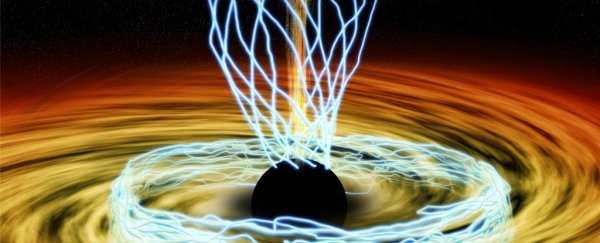We're a step closer to understanding how the black hole at the centre of our galaxy works, with astrophysicists in the US announcing that they've directly observed the magnetic fields just outside its event horizon for the first time ever.
That's a big deal, because it's these magnetic fields that are thought to power supermassive black holes. "These magnetic fields have been predicted to exist, but no one has seen them before," said one of the researchers, Shep Doeleman, from the Harvard-Smithsonian Centre for Astrophysics. "Our data puts decades of theoretical work on solid observational ground."
So why are magnetic fields so important to a black hole? While most of us think about black holes as huge galactic vacuum cleaners that suck in anything that gets too close, in reality, the ones at the centre of galaxies such as our own are more like cosmic engines.
This means they suck up nearby matter, but then convert it into intense radiation, which can make black holes brighter than all their surrounding stars combined. And even cooler: if a black hole is spinning, it can blast this radiation out across thousands of light-years in strong, galaxy-shaping jets. And it's magnetic fields that are thought to power these black hole engines.
"Understanding these magnetic fields is critical," said lead researcher Michael Johnson. "Nobody has been able to resolve magnetic fields near the event horizon until now."
To confirm whether these magnetic fields exist or not, the researchers looked to the black hole at the centre of the Milky Way, known as Sagittarius A-star (Sgr A*), using a global network of radio telescopes called the Event Horizon Telescope, which together form a giant telescope the size of Earth.
They needed a telescope that big because black holes are ridiculously small. Our black hole weighs roughly 4 million times more than our Sun, but its event horizon – the boundary at which nothing can escape from a black hole – is only 12.8 million kilometres across, which is pretty tiny on a galactic scale. Add to that the fact that Sgr A* is also located around 25,000 light-years away, and it makes it damn hard to see what's going on.
Thankfully, the Event Horizon Telescope is able to resolve features as tiny as a golf ball on the Moon. And with the added magnification effect of the black hole's intense gravity, that meant it was powerful enough to allow astrophysicists to study the area.
What they found was an incredibly intricate range of magnetic fields, which vary across the event horizon. Some parts of the magnetic field are incredibly disorderly, with jumbled loops jumping all over the place. But other areas have organised magnetic fields, and this could potentially be where the jets of energy originate.
To make the whole thing more confusing, the magnetic field fluctuates constantly, changing every 15 minutes or so.
"Once again, the galactic centre is proving to be a more dynamic place than we might have guessed," said Johnson. "Those magnetic fields are dancing all over the place."
The team will study these magnetic fields further using the Event Horizon Telescope, and hopefully their observations will help them figure out one of the longest-standing mysteries of our galaxy – why our black hole is so bright. We can't wait for more results.
The research has been published in Science.
And in case you want to know more about how the Event Horizon Telescope is able to study magnetic fields so far away, this cute cartoon breaks it down for you:
 Event Horizon Telescope
Event Horizon Telescope
